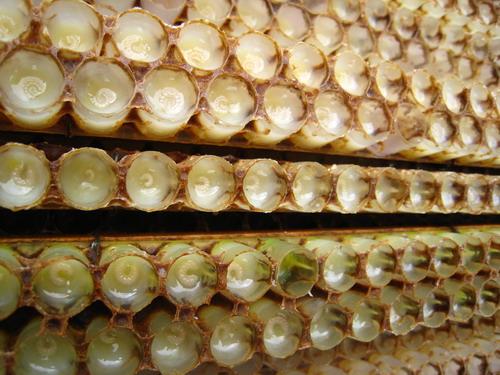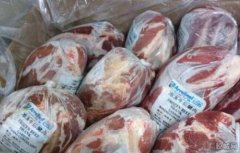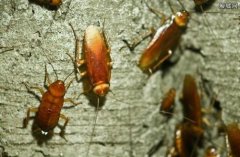Royal jelly: is the output of royal jelly high in China? How to increase the yield of royal jelly?
Now more and more people are raising bees, so we want to increase the production of royal jelly now, which is an important guarantee to improve the economic benefits of beekeeping. So how to increase the production of royal jelly? Do you know?

1. Cultivate a strong group so that the honeybee colony producing royal jelly can reach a foot group of more than 12 frames.
In honeybees, royal jelly is secreted by young bees and is the main food for queen bees and bee larvae. Therefore, in order to increase the yield of royal jelly, there must be more strong colonies of young bees, and the production of royal jelly must be adjusted in time. If there are only 6-7 frame-footed wasps, the high yield of royal jelly cannot be obtained. For this reason, it is necessary to increase the number of young bees and make the honeybee population grow to more than 12 frames of foot bees, so as to lay a good foundation for increasing royal jelly production.
two。 Prepare enough suitable age honeybee larvae to ensure the transfer of insects.
To produce royal jelly in large quantities, a lot of bee larvae are needed. Generally speaking, for each royal jelly frame moved, there must be at least hundreds of appropriate age bee larvae. If you look for them temporarily before moving the worm, it will take time and it will be difficult to find enough. Therefore, 5-6 days before each planned migration, empty spleen should be added to the newly grouped honeybee or double queen colony to allow the queen bee to lay eggs. In this way, by the time the worm is transferred, most of the larvae are the right instar larvae within 24 hours. Not only the number of larvae is large and the age is the same, the larvae in one frame can move more than 6 frames of royal jelly frame, but also the speed of worm transfer is accelerated, there is no need for temporary search, and time is saved. Work efficiency has been improved.
3. Adhere to timely collection of jelly to prevent bee larvae from eating more royal jelly
For the royal jelly secreted by young bees, if the pulp is taken too late and the honeybee larvae grow up, it is necessary to increase the consumption and reduce the yield of royal jelly. Therefore, the timely pulping time can be taken within 68-72 hours after the honeybee larvae are moved in, and scraping royal jelly can be arranged after 9 o'clock in the morning. Pulping should be scraped carefully to prevent larval body fluid from mixing into royal jelly, causing bubbling of royal jelly and affecting the quality.
4. Combined with feeding a large amount of sugar to prolong the production period of royal jelly
The production time of royal jelly is directly related to the yield. Therefore, in order to prolong the pulp production period, we can seize the auxiliary honey powder source and the honey-free period at the end of the honey period, combined with a large amount of sugar feeding, so that the production period of royal jelly can be effectively prolonged to increase the pulp yield.
5. Carry out reward feeding to stimulate the enthusiasm of worker bees to secrete plasma
The production of royal jelly mainly depends on the amount of jelly secreted by worker bees. In order to stimulate the enthusiasm of worker bees to secrete plasma, the bee colony should be rewarded and fed. The reward feeding time is the night before the pulp is taken. At this time, even in the honey period, if you encounter insufficient honey sources or insufficient storage of honey and powder, you must also be rewarded and fed.
- Prev

Why is imported frozen meat cheap due to the emergence of new tricks of frozen pork smuggling? what is the crime of transporting frozen meat?
Landfills can be turned into "gold mines" as long as they are black-hearted enough. Previously, frozen meat smuggled from Vietnam was often seized, and after each seizure, the authorities buried the frozen meat at the landfills in Sanjia Village. These frozen meat, which are regularly "delivered to the door", become a treasure in the eyes of the villagers.
- Next

Gold cockroach breeding value, breeding cockroach cost and benefit high?
Did you know that cockroach farming can also bring great benefits? What about the prospects for cockroach farming? The cost and benefit of breeding cockroaches are not high in the end. Let's take a look together. Xie Weiyan is the largest cockroach grower in Taiwan. He has cultivated nearly 100 cockroaches in a farm in Taishan District.
Related
- A one-day flower show brings 130 million yuan in orders! Nanhai, this Phalaenopsis exhibition is amazing
- What do the flower language and meaning of Lutheran tree mean? Precautions for planting Lutheran tree
- Encounter Chaoshan Kongfu tea, not without this cup of Phoenix single clump
- The durian market in Vietnam and Thailand is flooded. The price of imported durian has plummeted by 30-40% in a month.
- Shanghai solved the problem of local vegetable supply by planting 80,000 mu of green leafy vegetables.
- Wageningen University has become the best agricultural university in the world for the seventh time in a row.
- The strongest export season of South African grapes is full of challenges, with exports to Russia falling sharply by 21%.
- Sri Lanka is on the verge of bankruptcy, "Tea for debt" Organic Agriculture Revolution aggravates the Food crisis?
- Turning waste into earthworm manure and worm manure into organic fertilizer-A new choice for auxiliary farming
- Organic rice growers shoulder the responsibility of nurturing agricultural talents! Yinchuan Sustainable Farm with Organic Life Camp

